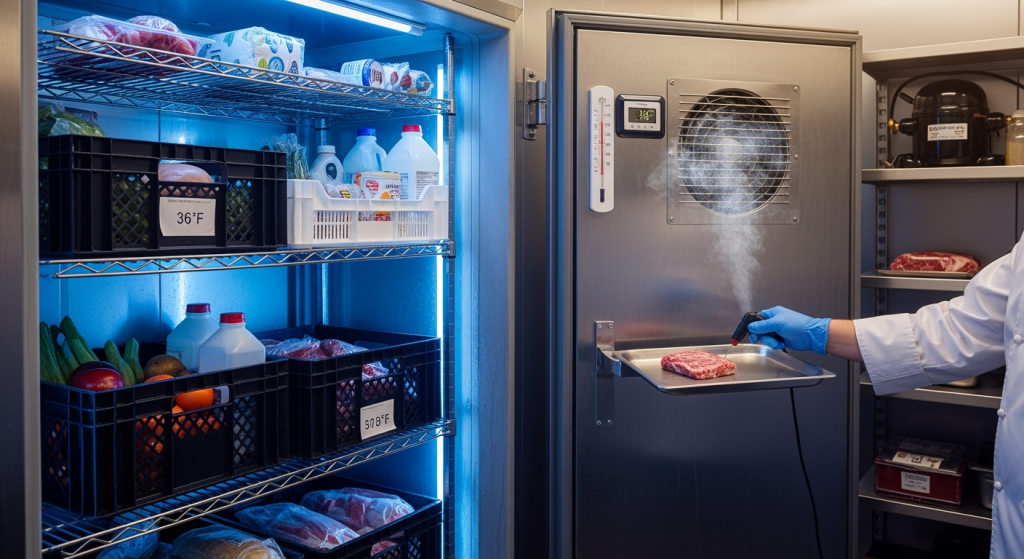
If you’ve ever worked a full shift with a walk-in on the fritz, you know it’s not just some metal box tucked in the back. It’s where your kitchen breathes, quietly. You don’t think about it much – until it stops doing its job. And when it does? That’s when the real mess starts.
People think the fridge in their home kitchen is tough – try running industrial refrigerators that have to keep bulk dairy, meat, produce, sauces, backups, overstock, and God knows what else cold in a single space, all day, every day, with cooks flying in and out like it’s a subway station.
The Compressor Doesn’t Complain – It Just Dies
Look, no one pays attention to the walk-in cooler compressor until it sounds like it’s chewing on gravel or refuses to shut off. That’s the red flag. That’s the beginning of your nightmare.
What usually gives it away?
- It won’t stop running, even when the door’s been closed for hours
- There’s that grinding sound… low at first, then unmistakable
- The cooler’s full but nothing feels cold enough anymore
I’ve had nights where I’ve had to haul crates of chicken thighs to the line fridge just to avoid tossing them. Not because of the cook’s mistake, but because the compressor quietly gave up during the lunch rush.
You Can’t Fake Cold
Cooler temperature is sacred. If it slips past 40°F, you’re playing chicken with food safety laws – and bacteria. Walk-ins need to hold steady around 35°F to 38°F. Freezers? Below zero. Not almost. Not close. Below.
Stuff that throws it off?
- Opening the door every five seconds to “just check”
- Door seals that don’t really seal anymore
- A thermostat that thinks it’s in Florida
You feel the difference. There’s a kind of stillness to a properly cold cooler. When it’s not right, you smell it first. Then the texture of everything’s off. Greens wilt faster, proteins look sweaty. Not a good sign.
Don’t Cheap Out on Equipment
I’ve worked kitchens where management bought the lowest-bid cooler and then acted surprised when it needed repairs every month. Walk-in cooler equipment isn’t something you pick out of a bargain bin. You want something that doesn’t flinch when the line gets slammed and six people hit it within five minutes.
Here’s what I always look for:
- Systems that don’t guzzle electricity
- Gear with actual support – not some 1-800 number in another country
- Parts that match the setup you already have
If your cooler and freezer aren’t in sync, things get weird fast. Defrost cycles overlap. Temp swings spike. Prep suffers. Morale drops. It’s a domino effect.
Maintenance Isn’t Optional
You can get away with skipping an oil change on your car. You can’t ignore your walk-in. Or you can – but you’ll pay for it.
Things that should be on your radar:
- Coils – dusty coils kill efficiency faster than you’d expect
- Compressor load – if it’s always working overtime, something’s off
- Thermostats – they lie more often than cooks do when the ticket printer jams
Every 3–4 months, give it a proper once-over. Pull the panel. Check the lines. Wipe it down. Let the compressor breathe. Maintenance isn’t glamorous – but neither is losing half your inventory because you didn’t clean a fan blade.
Nothing Runs Without It
Let’s be honest – kitchens are barely controlled chaos. The walk-in cooler, if it’s doing what it’s supposed to, makes everything else possible. It doesn’t get applause. It doesn’t need to. But when it stops, nothing else works.
So pay attention. Not just when it breaks, but before. Learn the sounds it makes. Feel the cold. Know when something’s off. And don’t let anyone convince you it’s “good enough” until it isn’t.
Because when the cooler goes down… so does everything else.